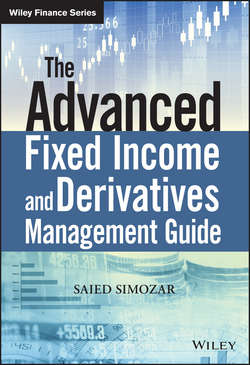The Advanced Fixed Income and Derivatives Management Guide

Реклама. ООО «ЛитРес», ИНН: 7719571260.
Оглавление
Saied Simozar. The Advanced Fixed Income and Derivatives Management Guide
List of Tables
List of Figures
Abbreviations
Notation
SUBSCRIPTS
VARIABLE NAMES
Preface
Acknowledgement
Foreword
About the Author
Introduction
Chapter 1. Review of Market Analytics
1.1 BOND VALUATION
1.2 SIMPLE BOND ANALYTICS
1.3 PORTFOLIO ANALYTICS
1.4 KEY RATE DURATIONS
Chapter 2. Term Structure of Rates
2.1 LINEAR AND NON-LINEAR SPACE
2.2 BASIS FUNCTIONS
2.3 DECAY COEFFICIENT
2.4 FORWARD RATES
2.5 PAR CURVE
2.6 APPLICATION TO THE US YIELD CURVE
2.7 HISTORICAL YIELD CURVE COMPONENTS
2.8 SIGNIFICANCE OF THE TERM STRUCTURE COMPONENTS
2.9 ESTIMATING THE VALUE OF THE DECAY COEFFICIENT
Chapter 3. Comparison of Basis Functions
3.1 POLYNOMIAL BASIS FUNCTIONS
3.2 EXPONENTIAL BASIS FUNCTIONS
3.3 ORTHOGONAL BASIS FUNCTIONS
3.4 KEY BASIS FUNCTIONS
3.5 TRANSFORMATION OF BASIS FUNCTIONS
3.6 COMPARISON WITH THE PRINCIPAL COMPONENTS ANALYSIS
3.7 MEAN REVERSION
3.8 HISTORICAL TABLES OF BASIS FUNCTIONS
Chapter 4. Risk Measurement
4.1 INTEREST RATE RISKS
4.2 ZERO COUPON BONDS EXAMPLES
4.3 EURODOLLAR FUTURES CONTRACTS EXAMPLES
4.4 CONVENTIONAL DURATION OF A PORTFOLIO
4.5 RISKS AND BASIS FUNCTIONS
4.6 APPLICATION TO KEY RATE DURATION
4.7 RISK MEASUREMENT OF A TREASURY INDEX
Chapter 5. Performance Attribution
5.1 CURVE PERFORMANCE
5.2 YIELD PERFORMANCE
5.3 SECURITY PERFORMANCE
5.4 PORTFOLIO PERFORMANCE
Chapter 6. Libor and Swaps
6.1 TERM STRUCTURE OF LIBOR
6.2 ADJUSTMENT TABLE FOR RATES
6.3 RISK MEASUREMENT AND PERFORMANCE ATTRIBUTION OF SWAPS
6.4 FLOATING LIBOR VALUATION AND RISKS
6.5 REPO AND FINANCING RATE
6.6 STRUCTURAL PROBLEM OF SWAPS
Chapter 7. Trading
7.1 LIQUIDITY MANAGEMENT
7.2 FORWARD PRICING
7.3 CURVE TRADING
7.4 SYNTHETIC SECURITIES
7.5 REAL TIME TRADING
Chapter 8. Linear Optimization and Portfolio Replication
8.1 PORTFOLIO OPTIMIZATION EXAMPLE
8.2 CONVERSION TO AND FROM CONVENTIONAL KRD
8.3 KRD AND TERM STRUCTURE HEDGING
Chapter 9. Yield Volatility
9.1 PRICE FUNCTION OF YIELD VOLATILITY
9.2 TERM STRUCTURE OF YIELD VOLATILITY
9.3 VOLATILITY ADJUSTMENT TABLE
9.4 FORWARD AND INSTANTANEOUS VOLATILITY
Chapter 10. Convexity and Long Rates
10.1 THEOREM: LONG RATES CAN NEVER CHANGE
10.2 CONVEXITY ADJUSTED TSIR
10.3 APPLICATION TO CONVEXITY
10.4 CONVEXITY BIAS OF EURODOLLAR FUTURES
Chapter 11. Real Rates and Inflation Expectations
11.1 TERM STRUCTURE OF REAL RATES
11.2 THEOREM: REAL RATES CANNOT HAVE LOG-NORMAL DISTRIBUTION
11.3 INFLATION LINKED BONDS
11.4 SEASONAL ADJUSTMENTS TO INFLATION
11.5 INFLATION SWAPS
Chapter 12. Credit Spreads
12.1 EQUILIBRIUM CREDIT SPREAD
12.2 TERM STRUCTURE OF CREDIT SPREADS
12.3 RISK MEASUREMENT OF CREDIT SECURITIES
12.4 CREDIT RISKS EXAMPLE
12.5 FLOATING RATE CREDIT SECURITIES
12.6 TSCS EXAMPLES
12.7 RELATIVE VALUES OF CREDIT SECURITIES
12.8 PERFORMANCE ATTRIBUTION OF CREDIT SECURITIES
12.9 TERM STRUCTURE OF AGENCIES
12.10 PERFORMANCE CONTRIBUTION
12.11 PARTIAL YIELD
Chapter 13. Default and Recovery
13.1 RECOVERY, GUARANTEE AND DEFAULT PROBABILITY
13.2 RISK MEASUREMENT WITH RECOVERY
13.3 PARTIAL YIELD OF COMPLEX SECURITIES
13.4 FORWARD COUPON
13.5 CREDIT DEFAULT SWAPS
Chapter 14. Deliverable Bond Futures and Options
14.1 SIMPLE OPTIONS MODEL
14.2 CONVERSION FACTOR
14.3 FUTURES PRICE ON DELIVERY DATE
14.4 FUTURES PRICE PRIOR TO DELIVERY DATE
14.5 EARLY VERSUS LATE DELIVERY
14.6 STRIKE PRICES OF THE UNDERLYING OPTIONS
14.7 RISK MEASUREMENT OF BOND FUTURES
14.8 ANALYTICS FOR BOND FUTURES
14.9 AUSTRALIAN BOND FUTURES
14.10 REPLICATION OF BOND FUTURES
Chapter 15. Bond Options
15.1 EUROPEAN BOND OPTIONS
15.2 EXERCISE BOUNDARY OF AMERICAN OPTIONS
15.3 PRESENT VALUE OF A FUTURE BOND OPTION
15.4 FEEDFORWARD PRICING
15.5 BOND OPTION GREEKS
15.6 RISK MEASUREMENT OF BOND OPTIONS
15.7 TREASURY AND REAL BONDS OPTIONS
15.8 BOND OPTIONS WITH CREDIT RISK
15.9 THEOREM: CREDIT PRICES ARE NOT ARBITRAGE-FREE
15.1 °CORRELATION MODEL
15.11 CREDIT BOND OPTIONS EXAMPLES
15.12 RISK MEASUREMENT OF COMPLEX BOND OPTIONS
15.13 REMARKS ON BOND OPTIONS
Chapter 16. Currencies
16.1 CURRENCY FORWARDS
16.2 CURRENCY AS AN ASSET CLASS
16.3 CURRENCY TRADING AND HEDGING
16.4 VALUATION AND RISKS OF CURRENCY POSITIONS
16.5 CURRENCY FUTURES
16.6 CURRENCY OPTIONS
Chapter 17. Prepayment Model
17.1 HOME SALE
17.2 REFINANCING
17.3 ACCELERATED PAYMENTS
17.4 PREPAYMENT FACTOR
Chapter 18. Mortgage Bonds
18.1 MORTGAGE VALUATION
18.2 CURRENT COUPON
18.3 MORTGAGE ANALYTICS
18.4 MORTGAGE RISK MEASUREMENT AND VALUATION
Chapter 19. Product Design and Portfolio Construction
19.1 PRODUCT ANALYZER
19.2 PORTFOLIO ANALYZER
19.3 COMPETITIVE UNIVERSE
19.4 PORTFOLIO CONSTRUCTION
Chapter 20. Calculating Parameters of the TSIR
20.1 OPTIMIZING TSIR
20.2 OPTIMIZING TSCR
20.3 OPTIMIZING TSCR WITH NO CONVEXITY
20.4 ESTIMATING RECOVERY VALUE
20.5 ROBUSTNESS OF THE TERM STRUCTURE COMPONENTS
20.6 CALCULATING THE COMPONENTS OF THE TSYV
Chapter 21. Implementation
21.1 TERM STRUCTURE
21.1.1 Primary Curve
21.1.2 Real Curve
21.1.3 Credit Curve and Recovery Value
21.2 DISCOUNT FUNCTION AND RISK MEASUREMENT
21.3 CASH FLOW ENGINE
21.4 INVOICE PRICE
21.5 ANALYTICS
21.6 TRADE DATE VERSUS SETTLE DATE
21.7 AMERICAN OPTIONS
21.8 LINEAR PROGRAMMING
21.9 MORTGAGE ANALYSIS
References
Index
WILEY END USER LICENSE AGREEMENT
Отрывок из книги
For notational convenience most variable names have been limited to a single character. Subscripts have been used to differentiate related variables. Subscripts i, j, and k have been used exclusively as running integers and are interchangeable. Other subscript letters are used to differentiate closely related names. For example, pm and pc are used for the market price and calculated price of a security, respectively. When these subscripts are mixed with running subscripts, a comma is inserted between them (e.g. pm,i or pc,k).
Understanding the factors that contribute to risk and return are essential, in order to structure a sound portfolio. Risk management and return attribution require the quantification of sources of risk and return and thus are math intensive. A portfolio manager who is familiar with linear programming can structure an optimum portfolio based on analysts' recommendations, portfolios policies and guidelines as well as his own views of the markets that is likely to have a superior return than another portfolio of similar weights and risk profiles.
.....
The change in the price of a security due to a small change in its yield in the continuously compounded framework is
1.18
.....